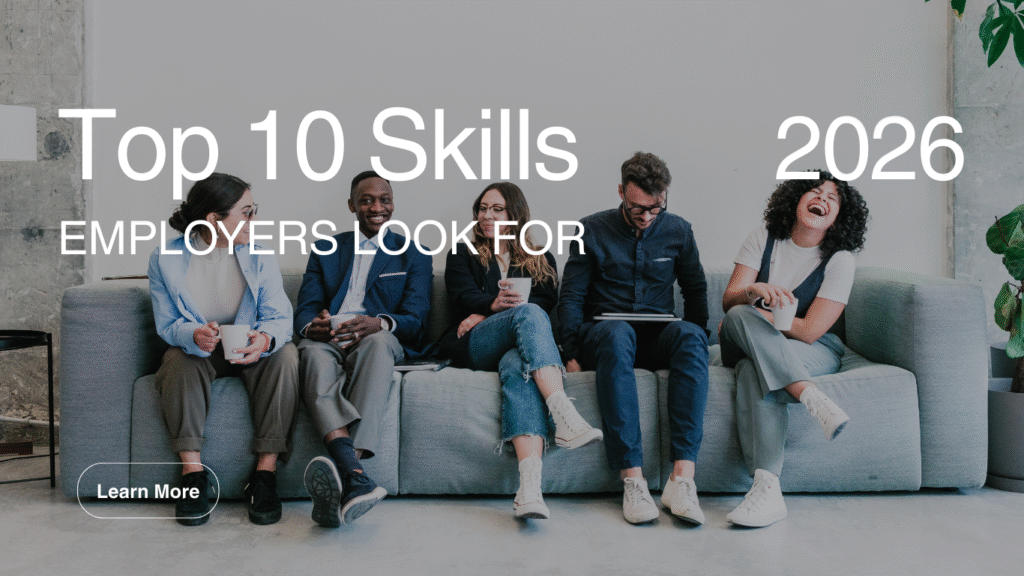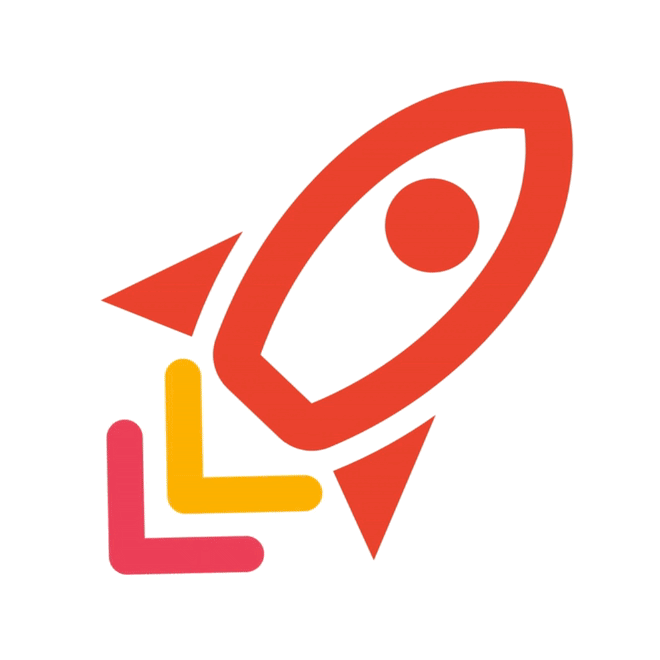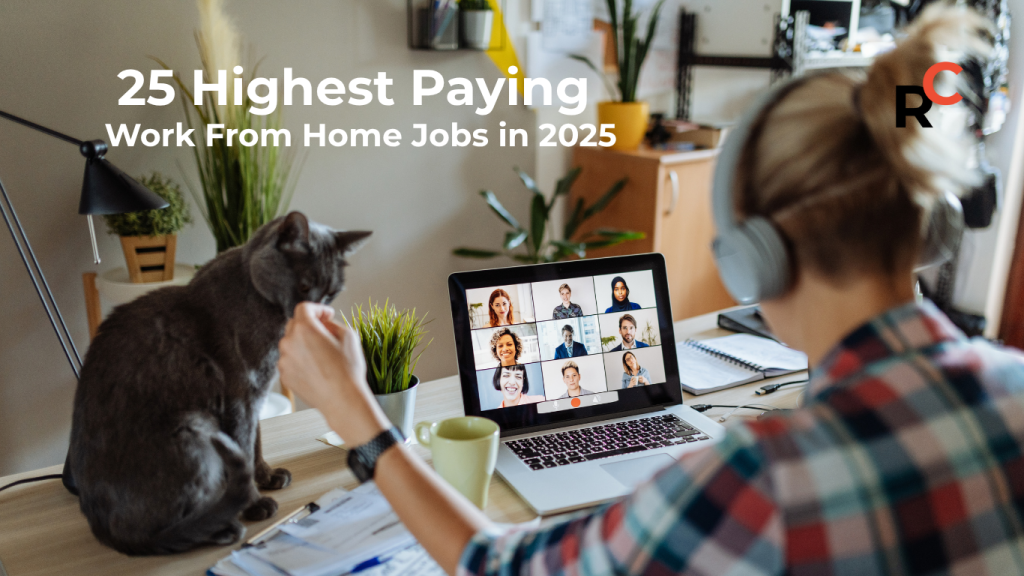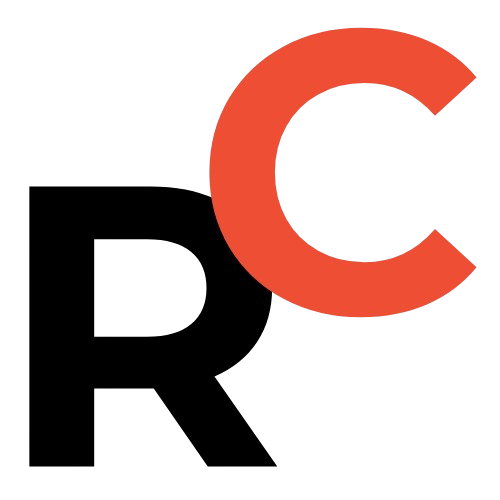
The Future of Work Is Closer Than You Think
Here’s a startling fact: by 2026, more than half of today’s professional skills will be outdated, according to the World Economic Forum. Think about that for a moment. You could spend years mastering your craft, only to discover the workplace has moved on – while you’re stuck with yesterday’s tools.
The job market is shifting faster than ever. AI is reshaping industries, remote work has gone global, and sustainability is no longer optional. For job seekers, that raises one critical question:
👉 Which skills will still matter in 2026 – and how can you prepare?
This post breaks down the top 10 skills employers want in 2026 and gives you practical tips to start building them now. Think of it as your roadmap to future-proofing your career.
Why Future Job Skills Matter in 2026
If you feel like the workplace is changing faster than your favorite app updates, you’re not wrong. Here’s why skills are evolving so quickly:
AI and automation are reshaping jobs
AI isn’t just for tech teams anymore. From chatbots in customer service to AI-driven analytics in marketing, nearly every profession now touches AI in some way. According to LinkedIn’s Future of Work report, demand for AI and data-related roles is growing at double-digit rates each year. But while AI can crunch numbers, it can’t replace human judgment, creativity, or empathy. That’s where your value lies.
Remote work makes the world your office
What started as a pandemic experiment is now the norm. Teams don’t just sit across the hall – they span continents. This means collaboration, cultural awareness, and digital communication aren’t “nice to have.” They’re career essentials.
Sustainability is shaping business decisions
Climate change and corporate responsibility are rewriting how companies operate. From supply chains to product design, employers are prioritizing green skills. The International Labour Organization predicts the green economy could create 24 million jobs by 2030.
In short, the world of work is being rewritten – and those who reskill now will be the ones employers fight to hire.
The Top 10 Skills Employers Want in 2026
Here’s what will set you apart in the job market of the future.
AI and Data Literacy
AI is everywhere, but success comes from knowing how to use it wisely. Whether you’re a teacher using AI to personalize lessons or a marketer analyzing customer data, AI literacy is now a core skill.
📌 Example: A mid-level marketer learned how to combine ChatGPT with Google Analytics. She automated her reporting, then used storytelling to present insights to leadership. That blend of AI and human skills earned her a promotion.
How to build it: Start with foundational courses on Coursera or LinkedIn Learning. Experiment with AI tools in your daily workflow, practice analyzing datasets, or create small side projects that showcase your data skills.
Cybersecurity and Digital Resilience
Cybercrime costs the global economy over $10 trillion annually (Cybersecurity Ventures). As companies digitize, they need employees who understand data safety – not just IT staff.
📌 Example: When a U.S. hospital was hit by ransomware, it wasn’t only the IT team that made a difference. Nurses, doctors, and admin staff had been trained to spot phishing attempts. Their awareness stopped the crisis from spreading further. That’s digital resilience in action.
How to build it: Learn basic cybersecurity principles—like phishing prevention and password management—through platforms like Cybrary or free modules from SANS Cyber Aces. Practice applying these principles in your daily digital life.
Sustainability and Green Skills
Employers want candidates who understand sustainability and ESG (Environmental, Social, and Governance). From reducing waste in retail to designing eco-friendly supply chains, these skills are in high demand.
📌 Case study: Unilever looks for employees who can think green. A supply chain manager who can show a track record of cutting emissions has an edge over someone who can’t.
How to build it: Take online courses in sustainable business or supply chain management. Volunteer for projects that reduce waste, energy, or resource usage in your company or community. Track measurable results to include in your resume.
Healthcare and Wellness Knowledge
With aging populations and a global focus on well-being, healthcare knowledge is valuable – even outside of traditional health roles. The WHO predicts a need for 40 million more healthcare workers by 2030, but wellness is also showing up in tech, HR, and corporate culture.
📌 Example: At Google, employees trained in mindfulness often lead wellness programs. They’re not doctors, but they improve productivity and retention – skills any employer values.
How to build it: Take online courses in wellness coaching, mental health awareness, or ergonomics. Apply the knowledge at work or in community projects and track measurable improvements.
Adaptability and Agility
If the pandemic taught us one lesson, it’s this: adaptability is career insurance. Employers want professionals who can pivot quickly, learn new tools, and stay calm under pressure.
📌 Example: Restaurants that survived COVID weren’t always the fanciest. They were the ones that adapted – launching delivery, meal kits, or contactless payment. The same goes for individuals: agility keeps you employed when the unexpected happens.
How to build it: Step outside your comfort zone—take on stretch assignments, rotate roles, or volunteer for projects outside your expertise. Reflect regularly on what you learned and adjust strategies quickly.
Emotional Intelligence (EQ)
AI can crunch data, but it can’t replace empathy. Managers with strong EQ motivate teams, reduce turnover, and navigate hybrid workplaces effectively.
📌 Case study: One manager I coached led teams in both the U.S. and Southeast Asia. By respecting cultural differences, adapting communication, and celebrating local holidays, he cut turnover by 30%. That’s EQ at work.
How to build it: Practice active listening, seek feedback on your communication, and learn conflict-resolution techniques. Courses in emotional intelligence or coaching can accelerate progress.
Critical Thinking and Problem-Solving
AI can provide answers, but only humans can ask the right questions. Employers want people who can analyze data, spot flaws, and make smart calls.
📌 Example: A financial analyst once spotted that an AI forecast ignored seasonality. Her intervention saved the company from a costly overinvestment. Critical thinkers aren’t just problem-solvers – they’re risk reducers.
How to build it: Challenge assumptions in your work, analyze data carefully, and ask “why” or “what if” questions. Practice solving complex problems through case studies, puzzles, or strategy games.
Cross-Cultural Collaboration
Global teams are the new standard. Success comes from bridging cultures, time zones, and communication styles.
📌 Case study: A Berlin-based tech company hired engineers from Brazil, India, and South Korea. Miscommunication slowed projects until a team lead trained in intercultural communication stepped in. Productivity soared – not because of new software, but because collaboration improved.
How to build it: Join multicultural teams, attend cross-cultural workshops, or take online courses in intercultural communication. Practice active listening and adapt your communication style to diverse audiences.
Creativity and Innovation
Machines can replicate tasks, but they can’t match human imagination. Creativity fuels innovation – and employers want people who bring fresh ideas to the table.
📌 Example: LEGO has survived generations by encouraging employee innovation. From movies to digital games, they constantly reinvent themselves, proving creativity is a long-term competitive edge.
How to build it: Experiment with side projects, brainstorm regularly, or take courses in design thinking. Document creative solutions you implement and highlight them in portfolios or resumes.
Leadership in a Digital World
Leadership is no longer about corner offices. Modern leaders must guide hybrid teams, adopt digital tools, and balance empathy with performance.
📌 Anecdote: Satya Nadella transformed Microsoft by shifting its culture from “know-it-all” to “learn-it-all.” His digital-first yet empathetic leadership style is exactly what employers want in 2026.
How to build it: Take leadership or digital management courses, mentor others, and practice leading small projects. Focus on communication, decision-making, and motivating teams in tech-enabled environments.
Practical Steps to Future-Proof Your Career
Knowing the top skills is one thing – but turning them into career growth requires a plan. Here’s how to take action and make sure you’re ready for 2026:
1. Audit Your Current Skills
Start by assessing your current skill set. Compare your resume against the top 10 in-demand skills listed above. Identify gaps and highlight areas where you already excel. This gives you a roadmap for where to focus your learning.
2. Commit to Continuous Learning
The world of work is constantly evolving, so learning can’t stop. Enroll in online courses, attend webinars, or complete certifications. Even dedicating 30 minutes a day to skill development adds up over time.
3. Apply Skills in Real Projects
Theory is important, but practice is critical. Look for stretch assignments at work, volunteer projects, or side hustles that let you apply new skills. These real-world experiences make your abilities tangible to employers.
4. Build a Professional Network
Mentorship and peer learning accelerate growth. Connect with professionals in your field, join LinkedIn groups, attend industry events, or participate in online communities. Your network can provide guidance, feedback, and even opportunities.
5. Track and Showcase Your Achievements
Document measurable outcomes from your projects or learning. Use numbers, results, and examples to make your accomplishments clear on your resume, LinkedIn profile, or portfolio. Employers value evidence of applied skills.
✨ Future-Proof Your Skills Checklist:
Completed one online course this year
Joined a professional networking group
Taken on a stretch project outside comfort zone
Practiced collaborating with people from different cultures
By following these steps, you’re not just learning skills – you’re building a resilient, adaptable career that stands out to employers in 2026 and beyond.
Accelerate Your Resume Success with AI-Powered Optimization
Try Resume Captain: AI-Powered Reseme Optimization
Want to fast-track your Resume optimization and ensure your profile meets recruiter standards? Resume Captain is an advanced AI tool designed specifically to analyze and optimize a resume for maximum recruiter attraction.

Welcome Aboard!
Initializing...
What Recruiters Are Already Saying
Employers aren’t waiting until 2026—they’re already seeking these skills:
Job postings mentioning “adaptability” have risen 21% in two years (LinkedIn, Future of Skills 2025).
44% of employers expect workers to reskill within the next five years (WEF).
Job listings referencing “AI” have tripled since 2020 (Glassdoor).
Recruiters notice when candidates highlight these skills clearly. For example:
Instead of “Strong communicator,” write: “Led weekly cross-cultural team meetings across three time zones.”
Instead of “Analytical,” write: “Used AI-powered analytics to identify trends, boosting ROI by 27%.”
Ask yourself: Does my resume showcase these future-proof skills—or is it time for an update?
Conclusion: Your Career in 2026 and Beyond
The top 10 skills employers look for in 2026 blend hard and soft skills: AI and data literacy, cybersecurity, sustainability, healthcare, adaptability, EQ, critical thinking, cultural collaboration, creativity, and digital leadership.
But here’s the key: success isn’t about collecting skills like trophies. It’s about adapting, blending human strengths with technology, and leading with purpose.
By 2026, the best jobs won’t go to those with the longest skill lists. They’ll go to people who can learn, grow, and inspire others through change.
So, here’s your challenge: audit your resume, pick one skill to start learning this month, and take action. The future of work isn’t waiting—why should you?




